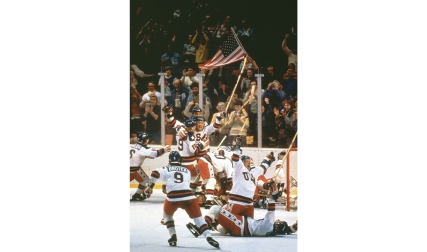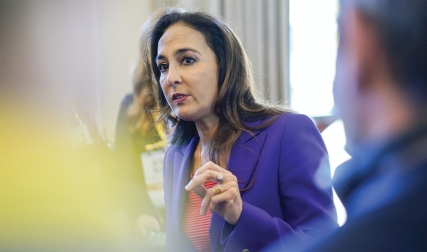Mr. Secretary In regard to Henry Paulson’s lament that he did not communicate the connection of Wall Street to Main Street [“After the Crash,” Mar/Apr], I suggest that he might have pointed out to Congress and the public that AIG managed many retirement funds. One of them was my hospital’s 403b plan. If AIG had been allowed to fail, the safety net of retirement that some Republicans think is best left to the private sector, and not Social Security, would have been shredded.
I was delighted to learn that Paulson was an English major and welcome him into Garrison Keillor’s English Majors Association. I think English majors become the most insightful readers, even if they earn their living as “quants.” It was an English major who first raised a question about Enron at Fortune. I suspect it was the English majors who first saw Lehman Brothers as a house of cards; the short-sellers merely followed their lead.
Anthony H. Horan ’61 Delano, California
As the 44-year spouse of a Dartmouth ’60 widow, I have had the opportunity to read and review DAM for many years. Your interview with Paulson was very well done. It did indeed confirm for me in no uncertain terms that a system-wide financial collapse was averted via the quick and effective actions of Messrs. Bush, Paulson, Obama, Geithner and Bernanke. Hooray for the five of them.
Orland Smith Naples, Florida
Thank you for the enlightening interview. Regardless of whether or not you agree with the actions taken by the federal government during the recent financial crisis, one thing that is clear is that Paulson actually did something, while so many others in Washington were posturing or hiding.
I believe history will be kinder to Paulson and current Treasury Secretary Tim Geithner ’83 than the critics have been thus far. Paulson and Geithner have done Dartmouth proud by upholding a tradition of stepping in to take action amid chaos and striving to do what made the most sense for the common good while resisting any politically expedient temptation to dogmatically cling to ideology. I hope the College will recognize their service to society in due course.
Douglas K. Chia ’93 Princeton Junction, New Jersey
Hank Paulson is a great credit to Dartmouth College and the class of 1968.
I moved from Riverside, Connecticut, to Barrington Hills, Illinois, in the early 1960s and received a call from Earl Hamilton A’49, who was the freshman football coach responsible for recruiting in the Chicago area for Bob Blackman. Earl was a fishing buddy of my father-in-law, Tom Dent.
The Paulson family was concerned about the drinking at Dartmouth, and Earl wanted me to contact them since they lived in Barrington Hills. My conversation was that there was drinking at Dartmouth, but it was a great small college and they would not make a mistake sending Hank to Hanover.
Dick Hinman ’45 New London, New Hampshire
Powering Up Scott Brown ’78 says [“Going Nuclear,” Mar/Apr] that “without nuclear power we have no hope of reaching targets for greenhouse gas emissions,” but he’s wrong.
New nukes are so costly that only governments will finance them—and they’re getting costlier. Wind, efficiency and cogeneration are all cheaper per kilowatt-hour, block one and a half to three times more CO2 per dollar and deploy 10 times faster. Nukes are agonizingly slow to build: A decade is typical, and commercialization of new designs or fuel cycles is even further off. That’s why global nuclear capacity has been flat since the 1990s, while U.S. wind capacity alone grew 14-fold from 2000 to 2009 with weaker subsidies.
One often hears that we need “all options on the table,” including nukes, but in real life we rarely need or can afford all options. A family on food stamps that tried to keep “all groceries on the table,” starting with caviar at $180 an ounce, would starve. Likewise, spending the gigabucks proposed for a “nuclear renaissance” would worsen global warming by squeezing cost-effective alternatives, leaving more CO2 overhead than if we’d spent rationally. Opportunity cost is real.
Nukes offer too little, too pricey, too late.
Larry Gilman, Th’95 Norwich, Vermont
Brown’s logic is impeccable, and I agree with everything he derives from his premise except for the premise itself: the existence of global warming. Global warming curves from NOAA, NASA and the Met Office, the U.K.’s national weather service, all show a so-called “late 20th-century warming” in the 1980s and 1990s that is purely imaginary.
Satellite temperature measure-ments show that during that time the temperature just oscillated up and down by half a degree until the giant super El Niño of 1998 showed up. Yet in the middle of this period NASA’s James Hansen gets up in front of the Senate and testifies that global warming has started and that carbon dioxide is the cause.
Both statements are demonstrably false. Despite this an entire global warming religion, from Kyoto to Copenhagen, was built on this voodoo science. By putting the official warming curves side by side with satellite data it can be shown that all three curves are cooked. As in falsified. This is scientific fraud. My book What Warming? shows exactly how it was done. You will also learn other important things about the climate including the cause of the super El Niño and how the present Arctic warming got started.
Arno Arrak ’51 Dix Hills, New York
Brown diminishes the nuclear waste problem. Whether it takes 10,000 or 100,000 years to reduce the radioactivity to a safe level, the problem remains unsolved considering such a time span.
Fast-neutron reactors coupled with pyro-metallurgical fuel reprocessing can consume 99 percent of natural uranium and accumulated waste from other reactors rather than 1 percent as conventional reactors do. The 1 percent remaining waste takes hundreds of years to become safe, not 10,000 to 100,000 years. The other 99 percent of the uranium becomes needed energy.
Fast-neutron reactors cost more, and reprocessed fuel could be diverted to provide bomb material. Lifting the processing prohibition and tight monitoring would be required.
Cost comparison including waste disposal may make fast-neutron reactors cost effective, with a solution to the radioactive waste problem as a bonus. The actual long-term waste disposal cost, hazards of uranium mining and transportation of radioactive waste belong in the conventional column but not in the fast-reactor column. A government subsidy to realize this multi-faceted solution would be more justifiable than rescuing incompetent banks, insurance companies and car manufacturers.
John Mills ’62 Nashville, Indiana
Golden Moments What a great Jan/Feb issue! I read every article. Also of interest but not mentioned is that David Lawrence ’51 was married to Andrea Meade Lawrence, a Rutland, Vermont, native and member of the women’s Olympic team in 1948 and 1952. Although she was not a student at Dartmouth, she was a resident of Hanover with David and the first woman to win two gold medals for the United States in the Winter Olympics.
Overton Chambers II ’53 Highlands, North Carolina
The Winter Olympics issue was superb. A couple of footnotes for those interested: Hockey was introduced into the Olympics at the 1920 Summer Games in Antwerp and there were two Dartmouth alumni on the U.S. team: Leon P. Tuck ’15 and George P. Geran ’18. They did us proud by coming home with silver medals.
David Orr ’57 Hanover
Henceforth I will treat all information contained in DAM with great skepticism given David Wilson’s puff piece [“Campbell’s Coup,” Jan/Feb]. I expected more accurate reporting.
Wilson says Campbell won backing for $800 million for Olympic venues but fails to point out the significant cost overruns. In commenting upon Campbell’s pushing through tax changes after the election Wilson failed to mention that less than a month after that election Campbell suddenly discovered the largest deficit in the province’s history and a pressing need to blend the federal and provincial sales taxes, something he said he would never do.
Finally, in an effort to pay for the Olympics Campbell has seized the earnings of the government-licensed gambling operations that were supposed to be devoted exclusively to the arts. His will be a legacy of debt and crippled arts and amateur sports sectors.
David E. Bond ’60 Westbank, British Columbia
Silver Fox Thanks to Ed Williams ’64 for the great story about Al Merrill [“The Silver Fox,” Jan/Feb]. What a trip down memory lane. No more than a year earlier I played out the very same naïve foray into the ski team world—with even less skiing ability and experience.
I climbed, ran, hiked and even enjoyed a good bit of soccer, then went directly to “ski rec” at a very intermediate level. Coming to grips with the reality that there had to be another way to contribute, I spent quite a bit of time “below the dam” and enjoyed four years managing crew.
I have long treasured Al Merrill’s smile and some good friends who were real varsity stars. Buster Welch ’63 lent me his jumping skis to represent South Mass on the 25-meter hill. I still look really good—on the green trails, as my grandchildren fail to entice me onto the black diamonds and bumps.
Tom Jester ’63 Deerfield, Illinois
A Different Time Reading your story about my good friend Ed Hermance ’62 [“It All Started With a Letter,” Nov/Dec 2009], I was reminded of the claustrophobic and psychologically terror-filled environment for gays in the 1950s—and a mandatory course called “The Individual and the College.” I remember a lecture by Dean Stearns Morse in which he discussed how often students who committed suicide were either gay or fearful of being gay. I am sure that such thoughts plagued many students.
I did develop good friendships with fine young men who, for the most part, were not in fraternities and were good students. Homosexuality was rarely discussed among us, but many years later we learned most of us were gay. Life was quite lonely at times, but I enjoyed my studies and learned from my classics and anthropology professors that there were civilizations and cultures where gays were not only tolerated but also exalted. Such knowledge helped me keep my sanity.
After studying in Italy on a Fulbright grant and attending Yale Law School I became so involved in business activities that my ties to Dartmouth became tenuous. Around 1990, however, I returned to Hanover and was pleasantly surprised by the changes I observed.
I’m sure being gay still causes some difficulties for students, but gay life is so much better for all of us. I commend DAM for recognizing Hermance’s contribution to improving the lives of Dartmouth’s gay students and to the cause of common decency and acceptance of a significant portion of the Dartmouth family.
J. Garfield DeMarco ’59 Hammonton, New Jersey
Bear a Cross Your tribute to Eugen Rosenstock-Huessy [“Christian Existentialist,” Nov/Dec 2007] may well serve as a prologue to a long and detailed three-page letter I addressed to the Dartmouth community following the recent visit to Saint-Cyr Au Mont D’Or (Rhone) of my fellow scholar and friend Harold Stahmer ’51.
Rosenstock-Huessy’s mission was to preach a temporal reordering of human society and the assumptions on which it potentially operates while embodying in his own person the means for doing so. He lived as a unique example of the Christianizing of the very thought-process itself—and its universal application to multiple areas of human endeavor: history, law, art, sociology, linguistics and psychology, for example. The list is too long to be completed in such brief compass. His life endeavors were light years distant from the vogue known as existentialism, about which he refused to give special lectures despite offers of lucrative stipends to do so.
He challenged his students and listeners to bear a cross either of thought or action. Those who did not meet that qualification in their settled adult lives cannot translate or interpret him for others, their ostensibly good intentions notwithstanding.
Robert G. Heath ’45 Saint-Cyr Au Mont D’Or, France




